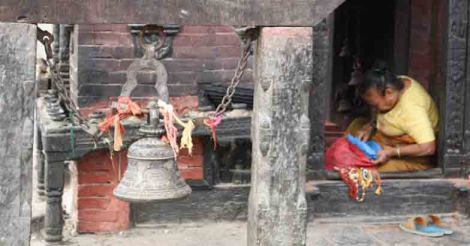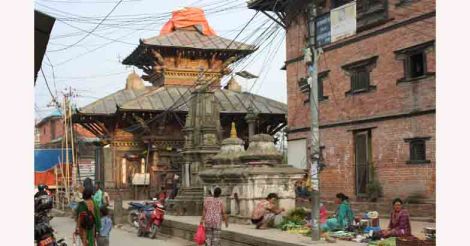It is very difficult to walk across the old parts of Nepal’s fabled capital Kathmandu and not notice the similarities in the architectural style of the temples here and those in Kerala. Kerala and the small Himalayan nation are worlds apart culturally but if one were to believe the many legends linking these two places, ties stretch back to antiquity.
Modern Nepal has a tiny but diverse and active Malayali community, comprising of ayurvedic doctors, professionals acting as a go-to men between Marwari businessmen and their Nepalese counterparts, business executives, Catholic nuns, pastors from various Christian denominations and the charming Sreejith Kartha, a well-known executive chef who enthusiastically promotes Kerala cuisine and culture.
Given the fact that the Kathmandu Valley was an important transit point on the route from India to Tibet, one can rest assured of the fact that many pilgrims, travellers and adventurers from the southern corner of India did live here at one time, with some eminent people leaving an indelible mark. Adi Shankaracharya is by far the greatest link between Kerala and Nepal. The Himalayan country’s most important temple, Pashupati Nath still has priests from Karnataka, a tradition that was set up by the Kerala-born Hindu philosopher.
The main structure of the Pashupati Nath temple looks very similar to temples in Kerala. As I wandered through some of the traditional areas of Kathmandu I could make many such comparisons, but many art historians have dismissed the thought of major Kerala-Nepal just on the basis of the architecture. Austrian-born art historian Stella Kramrisch, who taught at Shantiniketan in the 1920s and at the Calcutta University for over 25 years, didn’t make much of this connection. “Carved bargeboards, drop ornaments, pinnacles and finials show this type of wooden architecture allied not only to that of Nepal: wooden churches in Norway, Russia and the Balkans are members of the same family,” Kramrisch wrote about Kerala temples.
Another European scholar Ulrich Weisner wrote in his 1978 book 'Nepal Temple Architecture 'that Nepalese buildings are not primarily timber constructions, playing down the Kerala connection. “Nepalese temples are built rather of brick, with only the roof structure, false ceilings, and the frames and doors of windows consisting of wood,” Weisner wrote.

I am not qualified to argue with these scholars, but it would be hard for any international expert to come up with a plausible explanation for the existence of an Ayyappa corner in Pashupati Nath. The joke among the Malayali community in Kathmandu is that you can easily spot a Keralite in the famous temple if you see a person praying to the Ayyappa.
It is a well-known fact that the kings of Nepal were devotees of the Ananda Padmanabaswamy temple in Thiruvananthapuram. The royal dynasties of Nepal donated several pieces of jewellery to the Kerala temple, where Vishnu is enshrined in the ‘Anantha-sayanam’ or eternal sleep of yoga-nidra on the giant serpent Anantha. Devotees of Vishnu flock to Kathmandu’s Budhanilkantha temple, where the deity is in the same yoga-nidra. There are several myths and legends in Kathmandu that link Budhanilakantha with Ananda Padmanabaswamy.
Nair-Newari connection?
There are also several websites that claim that the Nairs of Kerala are the descendants of Newaris from Nepal. My host in Kathmandu, a Newari gentleman insists that there is truth to this. He cites as evidence, the similarity between Kathakali and Tibetan war dances, the fact that both communities have war goddesses, and the matriarchal system.
As someone who has always been fascinated with Tibet and Nepal, I would be happy if it was ever proved that the Bhadrakali poojas performed in my maternal grandfather’s house has some sort of deep connection with the Himalayan valleys.
There is also a belief that the Newaris brought the Pagoda (Bhagawati) architecture and angular roofs to Kerala. This may be the actual reason that there is such a strong resemblance between the temples in those places that are separated by thousands of kilometres. Then there is the serpent worship, which is an important tradition in both communities.

My Newari host even believes that the migration was two-way and that some members of the Nair community may have brought back subtle elements of Kerala cuisine to the rice-eaters of Nepal. Whether such connections exist between Nepal and Kerala or not, there seems to be a mixture of admiration and curiosity with which the Nepalese people look at God’s Own Country. Those inclined towards the Left speak of communist influence in the southern Indian state, while some others in this landlocked Himalayan nation admire the beaches and backwaters of Kerala.
There is an undeniable sense of familiarity and camaraderie between Kerala and Nepal. Let us hope that anthropologists and historians solve the mysteries of this great connection one day. In the meanwhile, I urge more people from India to come and see some of the dying traditions in this land, which feels as old as time.

























 Pashupati Nath temple, Nepal. | Photo: Ajay Kamalakaran
Pashupati Nath temple, Nepal. | Photo: Ajay Kamalakaran